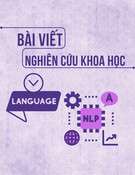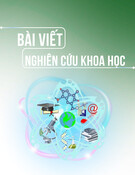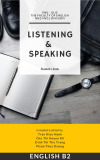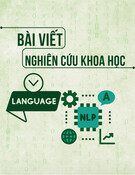
BM-003
TRƯỜNG ĐẠI HỌC VĂN LANG
KHOA: NGOẠI NGỮ
ĐỀ THI VÀ ĐÁP ÁN ĐỀ THI KẾT THÚC HỌC PHẦN
Học kỳ 3, năm học 2021 - 2022
Mã học phần: 72ENGL30093
Tên học phần: Nghe Nói 1 (Kỹ năng nghe)
Mã nhóm lớp học phần: 213_72ENGL30093_01
Thời gian làm bài (phút/ngày): 25 phút
Hình thức thi: Trắc nghiệm kết hợp tự luận
Cách thức nộp bài phần tự luận (Giảng viên ghi rõ yêu cầu):
- SV gõ trực tiếp trên khung trả lời của hệ thống thi;
Vui lòng Không đảo thứ tự câu hỏi phần nghe, không đảo các section
Các câu hỏi trắc nghiệm có thể đảo thứ tự đáp án
(Vui lòng thể hiện phần hướng dẫn bên dưới lên bài thi nghe của SV)
HƯỚNG DẪN:
Bài thi nghe có 4 phần. Sinh viên có 1 phút đọc câu hỏi trước khi nghe mỗi phần.
Lưu ý các phần chỉ được nghe 1 lần duy nhất. Sinh viên có 1 phút kiểm tra đáp án
mỗi phần sau khi nghe.
Một số phần có dạng câu hỏi trắc nghiệm và tự điền cho nên sinh viên lưu ý để không
bị bỏ lỡ câu hỏi.
Các câu hỏi tự điền có thể lấy thông tin nằm rải rác trong bài nghe và không nhất
thiết phải nằm ở cuối bài.
Sau phần thi nghe, sinh viên ở lại dự thi phần nói.
SECTION 1 – QUESTIONS 1 – 12
You will listen to the recording ONCE ONLY.
Listen to the conversation and choose the best answers.
1. Emma and Peter are talking about ___.
A. the good and bad things about mobile payment apps
B. how to use a mobile payment app when shopping
C. why mobile payment apps are so popular today
D. why Peter likes mobile payment apps
ANSWER: A
2. Why can’t Emma pay her rent?
A. She spent her money on other things.
1

B. She can’t use her mobile payment app.
C. She doesn’t know how to use a mobile payment app.
D. She gave her money to Peter.
ANSWER: A
3. Emma paid her friends using ___.
A. a mobile app
B. a credit card
C. cash
D. Peter’s money
ANSWER: A
4. How does Peter feel about mobile payment apps?
A. He thinks they can be dangerous.
B. He thinks they are useful.
C. He doesn’t care about them.
D. He doesn’t think they are easy to use.
ANSWER: A
5. Emma will borrow money from Peter. Which is the correct meaning of borrow?
A. to get money from someone and give it back in the future
B. to give money to someone who will give it back in the future
C. to ask for money to use now or in the future
D. to use another person’s money and not give it back
ANSWER: A
6. What prediction does Emma make?
A. People will stop carrying cash because they will use mobile payment apps.
B. Mobile payment apps are popular now, but in five years, people will return to using
cash.
C. There will be fewer mobile payment apps in the future.
D. Peter will begin using mobile payment apps tomorrow.
ANSWER: A
7. Emma believes her prediction is true because ___.
A. mobile payment apps are popular and so easy to use
B. everyone uses cash today
C. she likes to use mobile payment apps
D. in five years, there will be no more cash

BM-003
ANSWER: A
8. What prediction does Peter make about the future?
A. Some people will still want to use cash to pay for purchases.
B. Everyone will use only mobile payment apps to pay for purchases.
C. No one will want to use mobile payment apps.
D. Most businesses will not accept mobile payment apps.
ANSWER: A
Fill in the gaps with the correct information based on the conversation.
9. $__________ money sent last week
10. $__________ money sent three days ago
11. $__________ other mobile payment
12. Emma believes that people will stop carrying cash in_________ years
Đáp án câu 9: 250
Đáp án câu 10: 28
Đáp án câu 11: 167
Đáp án câu 12: 5 (years)
SECTION 2 – QUESTIONS 13 – 20
You will listen to the recording ONCE ONLY.
Listen to the conversation and choose the best answer.
13. What is the main idea of the listening?
A. how some businesses are going cashless
B. how Sweetgreen has saved money
C. why people prefer cashless businesses
D. why businesses don’t want to go cashless
ANSWER: A
14. According to the speaker, an example of Sweetgreen saving money is ___.
A. employees saving time because they do not count money
B. having fewer employees
C. employees not helping customers anymore
D. having customers order salads online
ANSWER: A
15. Which is an example of restatement?
3

A. We looked at the ways people make purchases, in other words, how they pay for
things.
B. Today, we will see how some businesses are going cashless and the problems this
is causing.
C. Customers must use a mobile app or credit card.
D. For instance, their employees don’t need to spend time counting money anymore.
ANSWER: A
16. What is another word that means prevent?
A. stop
B. guess
C. get
D. give
ANSWER: A
17. The professor says buying new technology saves money in the long run.
What does in the long run mean?
A. after a period of time
B. after exercise
C. after going cashless
D. after a day
ANSWER: A
18. At the Atlanta Falcons football stadium, where can a customer buy goods?
A. only at a kiosk or vending machine
B. only from a salesperson
C. from a store outside the stadium
D. from a salesperson and a kiosk
ANSWER: A
19. Elena thinks shopping from a vending machine is ___.
A. not very friendly
B. not very good
C. not very safe
D. not a good way to save money
ANSWER: A
20. Tyler doesn’t want to ___.
A. make small talk when shopping
B. go to an Atlanta Falcons football game
C. buy a T-shirt at a kiosk
D. shop at a kiosk

BM-003
ANSWER: A
SECTION 3 – QUESTIONS 21 – 30
You will listen to the recording ONCE ONLY.
Listen to the podcast and choose the best answer.
21. In the podcast, Madison does NOT talk about ___.
A. the outside appearance of the station
B. the size of the station
C. the history of the station’s construction
D. how popular the station is today
ANSWER: A
22. Madison describes the space in the Main Concourse as ___.
A. breathtaking
B. old
C. well-known
D. modern
23. Which sentence best describes the ceiling?
A. It’s curved, with a painting of the night sky on it.
B. It’s flat and has a bluish-green color.
C. It’s square and has gold-colored stars covering it.
D. It’s a triangle, with more than 2,500 stars painted on it.
ANSWER: A
24. Grand Central Depot was the name for Grand Central Station in ___.
A. 1871
B. 1899
C. 1903
D. 1913
ANSWER: A
25. What happened just before they closed the main building of the old station in
1910?
A. They started running trains on new tracks.
B. They opened the new station.
C. They finished work on the new station.
D. They destroyed buildings to make space for the new station.
ANSWER: A
26. How many people take trains in and out of Grand Central Terminal every year?
A. 60 million
B. 16 million
5












![Đề cương môn Tiếng Anh 1 [Chuẩn Nhất/Mới Nhất]](https://cdn.tailieu.vn/images/document/thumbnail/2025/20251130/cubabep141@gmail.com/135x160/51711764555685.jpg)










![Mẫu thư Tiếng Anh: Tài liệu [Mô tả chi tiết hơn về loại tài liệu hoặc mục đích sử dụng]](https://cdn.tailieu.vn/images/document/thumbnail/2025/20250814/vinhsannguyenphuc@gmail.com/135x160/71321755225259.jpg)


